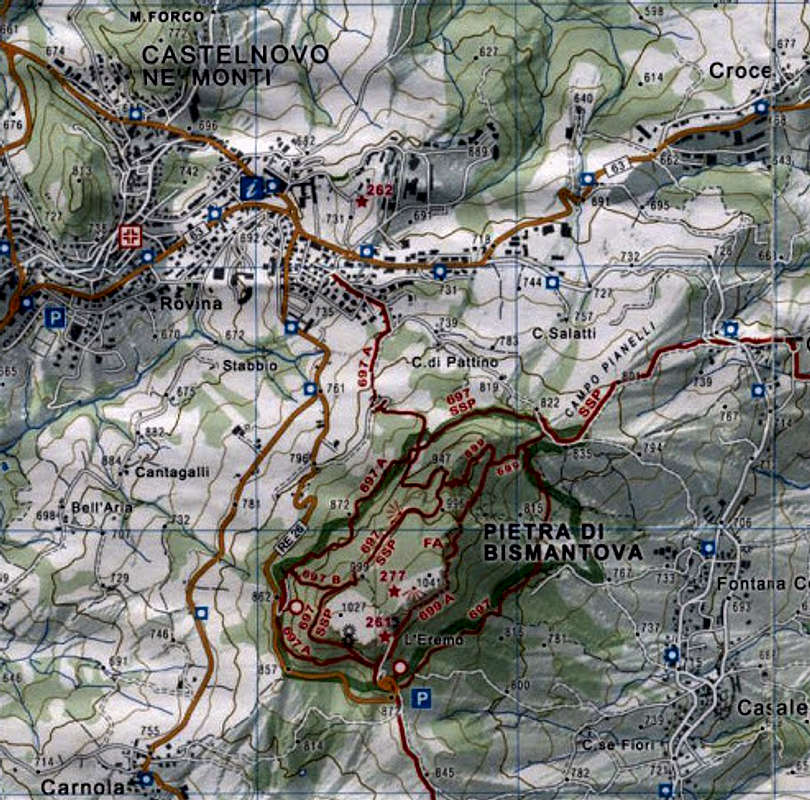-
 3861 Hits
3861 Hits
-
 83.09% Score
83.09% Score
-
 16 Votes
16 Votes
|
|
Mountain/Rock |
|---|---|
|
|
44.42107°N / 10.41309°E |
|
|
Hiking, Trad Climbing, Sport Climbing, Bouldering, Aid Climbing, Via Ferrata |
|
|
Spring, Summer, Fall, Winter |
|
|
3435 ft / 1047 m |
|
|
Overview
Pietra di Bismantova 1047 m
Pietra di Bismantova 1047 m is a large and spectacular sandstone cliff in the shape of a huge ship, belonging to the Appennino Reggiano, a sub-area of the largest area of Appennino Tosco-Emiliano e Tosco-Romagnolo and located near the small town of Castelnuovo ne’ Monti, located in the Reggio province, Emilia-Romagna region. Sometimes simply called "la Pietra", it's a huge and high arenaceous rocky crag with a very particular conformation as an isolated massif among the soft profiles of the hills surrounding the town.
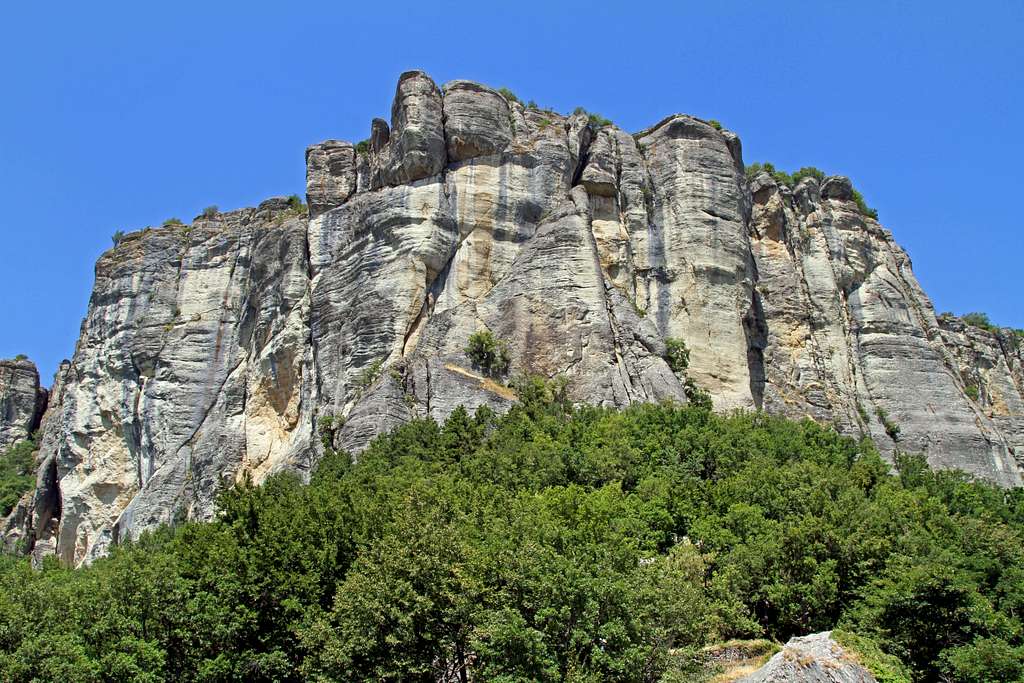
On the top it extends a flat and wide grassy plateau, somewhere covered by shrub vegetation, mainly the hazelnut, while at the base there are meadows and woods of oaks and lime trees that are having a considerable expansion. This fact is starting to hide from view the beautiful and peculiar rocky walls that give the landscape a connotation truly unique in the world. It is one of the best known and most appreciated symbols of the Parco Nazionale dell'Appennino Tosco-Emiliano.
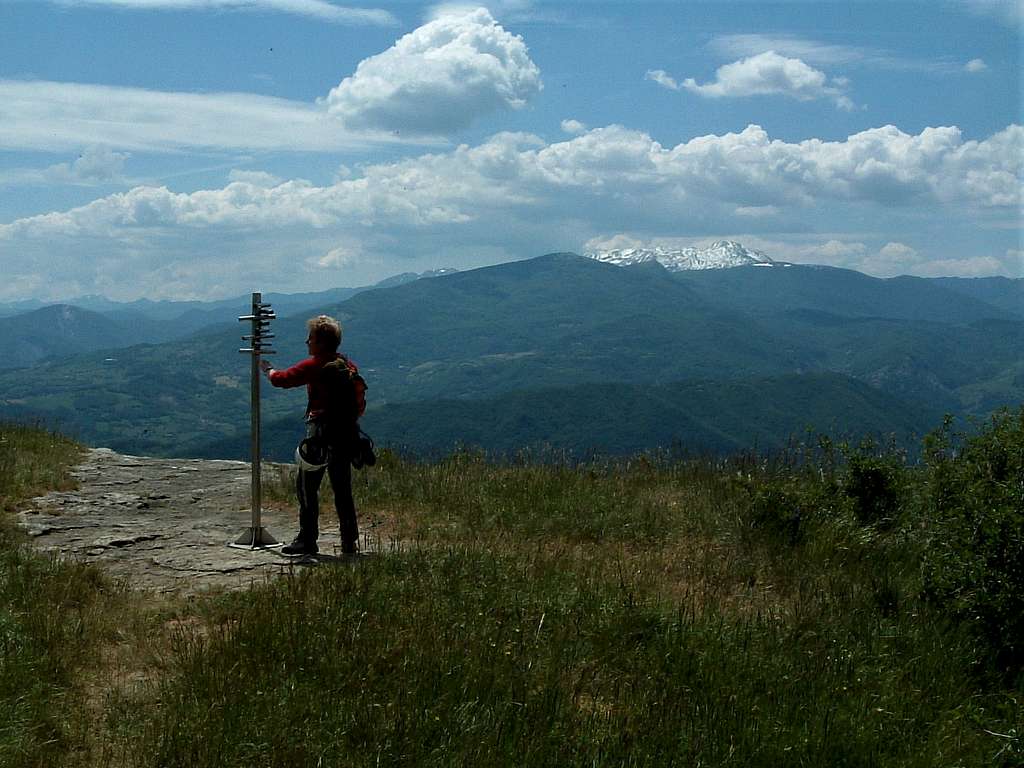
The Pietra di Bismantova is considered to be the most interesting and complete climbing area in the Emilia Romagna region. The rock is a compact and often smooth sandstone, and the walls vary in height from 120 meters at their highest point to 70 meters at the lowest point on the West wall. Over 300 climbing routes are located on them, from multipitches to sporty single pitches. Climbing is mainly of balance and technique and is usually practicable throughout the year.
The Pietra di Bismantova, however, is not just climbing. An easy hiking itinerary starts from the square at the base of the SE walls and leads to the top of the cliff in about 30 minutes. From the top you can enjoy an extraordinary view of the entire Appennino Reggiano and partly of the Parma and Modena Apennines. A well-signposted path completes the entire circumnavigation of the Pietra, which here coincides with the "Sentiero Spallanzani", the long trekking itinerary in stages that connects Ventoso di Scandiano with San Pellegrino in Alpe in Garfagnana. Different trails of great naturalistic and landscape interest also lead to the discovery of the surroundings, up to the river Secchia bed, where there is a "Nature Trail" dedicated to the Triassic chalks.

History
This mighty rock was formed in a shallow marine environment in a phase of tropical climate, a fact testified by the discovery of mollusc shells and large fish teeth. The formation of the cliff dates back to the lower middle Miocene, ie about 15 million years ago. The area has been inhabited since ancient times, as confirmed by the archaeological finds in the locality Campo Pianelli. Under the South-East wall of the Pietra there is a Benedictine hermitage prior to the 14th century, which developed around a pre-existing chapel.
The Pietra di Bismantova, together with the Rocca di San Leo and Noli, is mentioned in the Divina Commedia by Dante Alighieri which compares it with the mountain of Purgatory. I report the very famous verse in Canto IV of Purgatory: “Vassi in Sanleo e discendesi in Noli / montasi su in Bismantova e ‘n Cacume / con esso i piè; ma qui convien ch’om voli”, which can be translated like this: "On foot you climb San Leo, descend to Noli, climb to the top of Bismantova; but here you need to fly". Bismantova, like the other two places mentioned, is a term of comparison to describe the harshness and the difficulty of the ascent to the mountain of Purgatory, which is enormously more difficult: they are all mountains that can be climbed on foot, "but here - it means on the mountain of Purgatory - you need to fly"". According to historical data, Dante actually visited the Pietra di Bismantova, probably in 1306.
Brief climbing history
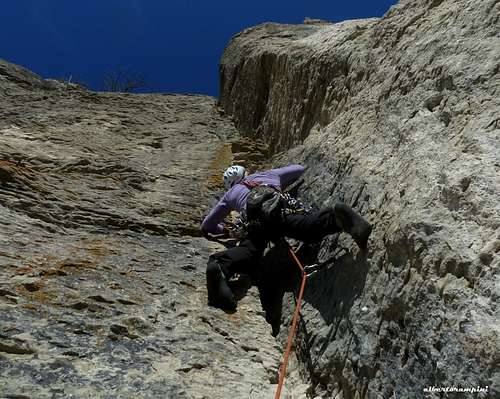
The first route of Bismantova was explored by Carlo Voltolini who soloed the Via degli Svizzeri in the year 1922. The name is probably due to the fact that Voltolini climbed with a companion of Swiss origins. Today this route is banned from climbing on holidays and days before holidays.
The second route was via Oppio by the famous alpinist Nino Oppio with Leopoldo Guidi and Aldo Farioli who, to overcome the smooth overhanging chimney of the second length, resorted to throwing the rope around the tree. The first repetition of the route was by the two strong alpinists Armando Corradini and Olinto Pincelli who climbed completely free. A few days later (1940, October 12nd) they came back to open their first route on the dihedral above the Hermitage, the third route of Bismantova, the Pincelli-Corradini, on which today the climb is prohibited on holidays and days before holidays due to the danger of falling stones on the square of the Hermitage. In the following years Pincelli opened some other climbing routes.
In the 1960s a new phase began with the appearance of aid climbing. The first aid route was the "Zuffa-Modoni" opened in 1960 by the Bolognesi Luigi Zuffa and Benito Modoni. The Zuffa brothers, Luigi and Giancarlo, in that period opened many new routes, today often climbed and highly appreciated, by exploiting cracks and chimneys, with limited recourse to aid climbing and with a very sparing use of pegs. Numerous other mainly artificial routes were opened in the late 60s and 70s according to the fashion of the time, such as the Via del Centenario and the Via CAI Parma, which joined other mainly free itineraries such as the Via Donato Zeni, the Via del "G.A.B." the "Via Nino Marchi" in 1971. At the same time as the Bolognesi, a small group of climbers from Parma also explored the walls of Bismantova, including Antonio Bernard, Pietro Menozzi and Andrea Pandolfo, with several significant first ascents including the already mentioned via del GAB, via Donato Zeni and via Nino Marchi.
Starting in the mid-1970s, free climbing on high degrees of difficulty began to take hold along previously aided routes and also on new routes. In the mid-1980s, with the advent of smooth-sole shoes, the spirit of free climbing began to spread, which soon turned into sport climbing. The first bolts began to appear with which the first single pitches were equipped. New routes were opened and the old routes were gradually rebolted.
Getting There
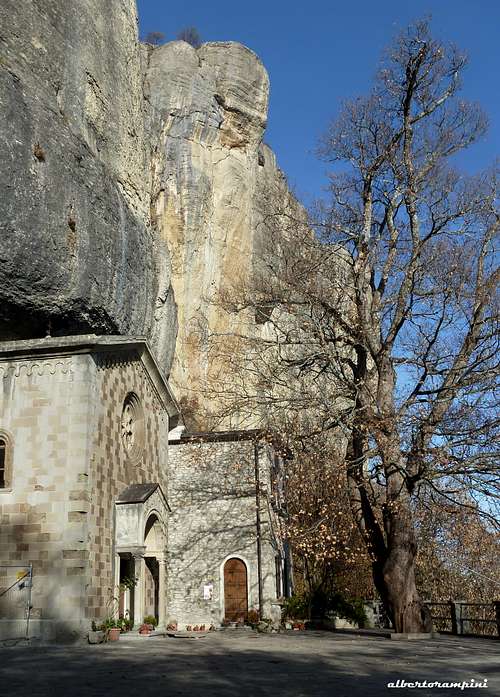
The center of reference is the small town of Castelnovo ne' Monti, located a few kilometers from the cliff.
Road access to Castelnovo ne' Monti
- From Reggio Emilia reach Puianello, Casina, Felina, Castelnovo né Monti (State Road 63, km 45)
- From Parma reach Traversetolo, Vetto d'Enza, Castelnovo né Monti (State Road 513, km 60)
- From Modena reach Sassuolo, Felina, Castelnovo né Monti (State Road 486, km 64)
- From La Spezia reach Aulla, Fivizzano, Passo del Cerreto, Castelnovo né Monti (State Road 63, km 84)
From Castelnovo né Monti follow the signposts to Pietra di Bismantova and quickly reach Piazza Dante (parking). From here you walk up the paved road to the Benedictine hermitage, where the various paths begin. The various climbing sectors can be reached starting from the hermitage or the Rifugio della Pietra located above the staircase with approaches varying from 5 to 30 minutes.
Rock Climbing
The most important walls for the multipitch climbing are the East wall, the South-East wall, a long coastline of about 110 m high for the development of about 700 m, and the South wall, overlooking the parking lot of Piazzale Dante and developing to the left of the "Sfinge" (Sphinx), an easily identifiable roof similar to the prow of a ship. The height of the Douth wall varies from 120 meters at its right end near La Sfinge to 40 meters near of the Torrione Sirotti at its left end. The West face facing Castelnovo né Monti is lower and less frequented. At the eastern end of Pietra di Bismantova two ancient rock landslides descend until they almost touch the hamlets of Fontana Cornia and Casale, creating the two climbing areas of the Orto del Mandorlo and Sassaia.
Below there is a selection of the most classic and popular routes among the over 300 existing.
Via Zuffa Ruggero
Difficulty: V+ max
Length: 140 m, 5 pitches
Exposition: South
First ascent: G. Zuffa - F. Ruggero on 24/07/1971
It is a beautiful classic from Bismantova and has varied climbing in the crack, chimney, slab and dihedral.
Approach: from the Piazzale Dante car park you can take the uphill road or the staircase, then the asphalted road leading to the Hermitage. Without getting to the hermitage, take the path on the left which passes under the South wall and above the refuge. Leave the path when some traces branch on the right. The start is on the left side of the sector, at the base of a crack rising to a small terrace with a tree. On the right there are some single pitches ("Gare vecchie" sector) and even further to the right the start of another multipitch, the via Donato Zeni.
L1 - Crack and dihedral IV+, 25 m / L2 - Chimney, belay to the right IV, 35 m / L3 - Right traverse, then slab V+, 25 m / L4 - Dihedral V, 20 m / L5 - Dihedal-chimney V, 30 m
Descent: walk along the edge of the Pietra to the left (facing in), until you find the "blue path" (blue stamps, passages of I) near an obvious large crack, which descends alongside the Torrione Tower, then reaching the Normal path which takes you back to the start (15 minutes).

Via Oppio
Difficulty: V max
Length: 130 m, 5 pitches
Exposition: South-East
First ascent: Nino Oppio, Leopoldo Guidi, Aldo Farioli on 7/04/1940
Another fine classic with an inner style of climbing inside an obvious chimney
Approach: from the Piazzale Dante car park you can take the uphill road or the staircase, then the asphalted road leading to the Hermitage. From the hermitage, take the path to the Ferrata, pass the Amphitheater and Pilone Giallo sectors, pass through a small cave and go up towards the SE wall where you follow the flat path that runs along the wall until the start of the route under the very obvious and deep chimney with a tree in the middle (0.20 hours).
L1 Starting slab and yellow chimney, IV+, 50 m / L2 Key pitch in the chimney with the big oak in the middle, V, 20 m. / L3 Still in the chimney up to the belay under a bottleneck, IV+, 30 m / L4 Overcome the bottleneck and exit to the summit plateau, V-, 35 m
Descent: see the previous route
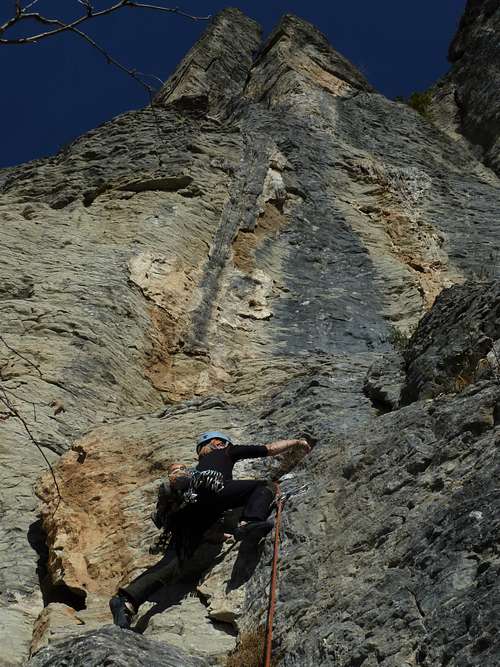
Diedro UISP
Difficulty: V max
Length: 130 m, 5 pitches
Exposition: South-East
First ascent: G. Montipò e R. Olmi
A brief route having an aestethic line overcoming a superb dihedral
Approach: from the Piazzale Dante car park you can take the uphill road or the staircase, then the asphalted road leading to the Hermitage. Without getting to the hermitage, take the path on the left which passes under the South wall and above the refuge. Walk along the path and after having passed the first sector you meet the Blue Path on the right. At the crossroads leave the main path following the easy rocks of the Sentiero Azzurro (Blue Path) which climbs to the right up to the wall with an obvious and easily recognizable corner.
L1 Climb a thin crack an area with yellow erosions. After a chimney climb an easy ramp and a short slab. Exit to the right V+, 40 m / L2 Follow the dihedral, VI +, 35 m
Descent: see the previous routes
Other advisable multipitches

Other recommended multipitches:
- Via Nino-Marchi
- Via Donato Zeni
- Via Zuffa '70
- Via delle 2 fessure
- Via Montipò-Olmi
- Via CAI Parma
and among the easy climbs i remember the
- Via Pincelli-Brianti
Other activities
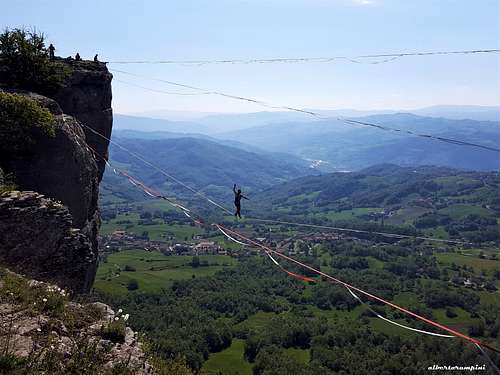
There are also two Via Ferrate that lead to the top. In fact, since 1971, a via ferrata has been equipped, called Via ferrata degli Alpini. In 2017 it wa realized a second ferrata called Via ferrata Ovest o dell'Ultimo Sole, of less difficulty than the other.
As well as climbing on multipitches and single pitch routes and via ferrata, Pietra di Bismantova offers the possibility of practicing other outdoor activities, such as hiking, biking or traveling on horseback along the paths reaching the summit of the mountain. An interesting route is the "Anello della Pietra", a ring of 16 km that surrounds the mountain, excellent for trekking, mountain biking, Nordic walking, roller skis and running. This itinerary starts from Castelnovo Monti and passes through the villages of Carnola, Ginepreto, Vologno, Maro, Casale and Campolungo. Moreover the territory of Bismantova is crossed by the Sentiero Spallanzani, a path starting from Scandiano reaching San Pellegrino in Alpe, crossing the Pietra di Bismantova and the Triassic Gypsum.
The flat summit of the Pietra is also ideally suited for slacklining, a spectacular sporting activity that has been developing in recent years.
Red Tape
No fees no permits required. Be aware that from June to the end of September, on all Saturdays and Sundays, parking in piazzale Dante will be subject to charges. Also pay attention that climbing on some routes (Svizzeri, GAB, Pincelli-Corradini and Elena-Eleonora) is prohibited during holidays and pre-holidays
When to Climb
Except for some particularly cold periods during the winter, it is possible to climb throughout the year
Accomodation
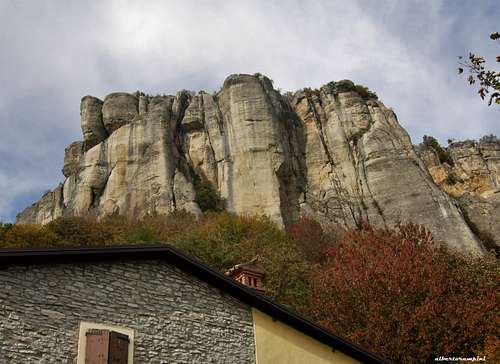
- Foresteria San Benedetto at foot of Pietra di Bismantova
Different possibilities in Castelnovo né Monti
Meteo
Guidebooks and maps

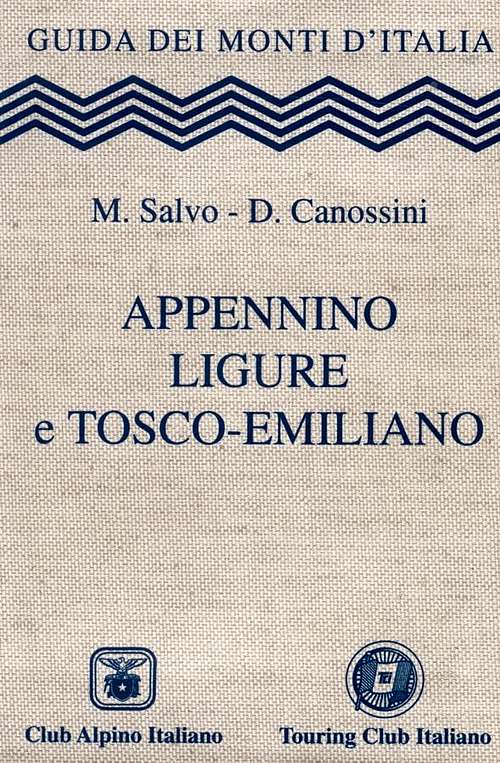
"Pietra di Bismantova. Vie e Falesie", D. Filippi e M. Bortolotti - Ed. Versante sud 2015
"Appennino Ligure e Tosco-Emiliano", Daniele Canossini, Collana Guide dei Monti d'Italia CAI-TCI
